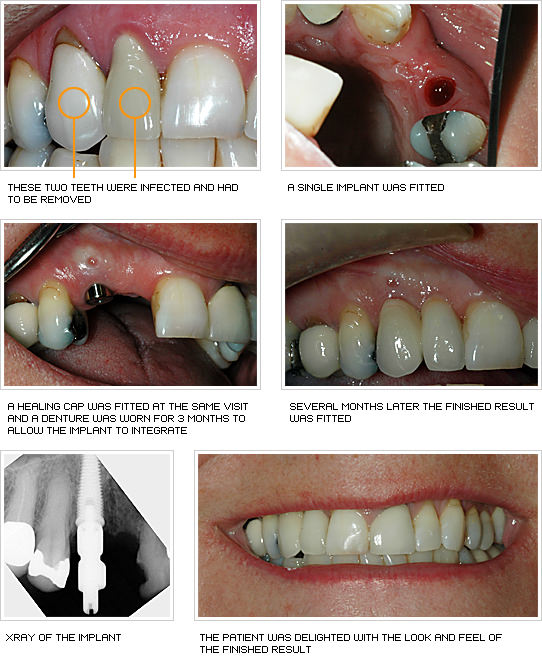All about Dental Sense
All about Dental Sense
Blog Article
The smart Trick of Dental Sense That Nobody is Talking About
Table of ContentsA Biased View of Dental SenseExamine This Report about Dental SenseThe Only Guide for Dental SenseDental Sense Can Be Fun For Everyone
are medical devices operatively dental implanted right into the jaw to bring back a person's ability to chew or their look. They provide support for man-made (fake) teeth, such as crowns, bridges, or dentures. When a tooth is shed because of injury or disease, a person can experience issues such as rapid bone loss, faulty speech, or changes to chewing patterns that result in discomfort.Dental dental implant systems include an oral implant body and dental implant joint and may additionally include an abutment addiction screw. Same day dental implants. The oral implant body is operatively inserted in the jawbone instead of the tooth's origin. The dental implant abutment is normally connected to the dental implant body by the joint addiction screw and expands with periodontals right into the mouth to sustain the affixed synthetic teeth
(https://hubpages.com/@dentalsense1)Structure of The Oral Implant System selecting dental implants, speak to your oral service provider about the possible advantages and risks, and whether you are a candidate for the treatment. Points to consider: Your overall health is an important element in figuring out whether you are a great prospect for dental implants, the length of time it will take to heal, and how much time the implant may remain in place.
Smoking might impact the recovery process and reduce the long-lasting success of the implant. The recovery procedure for the implant body may take numerous months or longer, throughout which time you typically have a short-lived abutment in area of the tooth. the dental implant procedure: Carefully adhere to the dental health directions provided to you by your oral provider.
Not known Facts About Dental Sense
Implant failure can lead to the demand for an additional procedure to fix or replace the dental implant system. Recovers the ability to chew Restores aesthetic appearance Helps maintain the jawbone from diminishing as a result of bone loss Preserves the wellness of the bordering bone and periodontals Aids keep surrounding (close-by) teeth steady Improves lifestyle Damages to surrounding natural teeth throughout dental implant positioning Injury to the surrounding cells during surgical procedure, such as sinus perforation Injury during surgical procedure (as an example, fracture of bordering jawbone) Insufficient feature, such as seeming like the teeth do not attack with each other generally An experience that the tooth is loose or twisting in position resulting from an abutment screw loosening up Implant body failure (looseness of the dental implant body) due to systemic infection, which might be a lot more likely in individuals with uncontrolled diabetes because of local infection in bone and periodontals supporting the dental implant body because of click to investigate postponed recovery, which may be more most likely in clients who smoke Trouble cleaning up the periodontals around the implant, causing inadequate oral hygiene Neglected gum illness Post-surgical tingling due to nerve impingement or damage Always alert health and wellness care providers and imaging technicians that you have oral implants before any kind of magnetic vibration imaging (MRI) or x-ray procedures.
FDA is not knowledgeable about any kind of adverse events reported for MRI or x-ray procedures with dental implants. Oral implants systems are typically made from products that adhere to global agreement standards of the International Company for Standardization (ISO) or ASTM International. These standards have information of what makes a secure product.

An oral implant is a structure that replaces a missing out on tooth. With screw-like devices, the doctor inserts an implant into the jawbone, and it acts as an anchor for an artificial tooth, called a crown.
The Best Strategy To Use For Dental Sense
Some people are not eligible for dental implant surgery. It is for oral specialists to operate on people with: intense illnessuncontrollable metabolic diseasebone or soft cells illness or infectionIf these issues are solved, an individual can have the surgery. In, dental cosmetic surgeons avoid operating people with: If people with any one of the above undergo oral implant surgical procedure, there is a greater threat of the implant failing.

Oral dental implant surgical procedure is a customized procedure. It's not the very same for everybody. The adhering to provides a basic review of what you can expect your dental expert, dental surgeon, periodontist or prosthodontist to do: Place the implant operatively. Give you time to recover. Attach the message and final crown, bridge or denture.
Next off, your specialist will very carefully put the dental implant into your jaw. If your implant is near the front of your mouth, your dental expert will certainly make a momentary tooth for you to put on up until you recover.
9 Simple Techniques For Dental Sense
Your provider can tell you what to anticipate in your circumstance. During the healing phase, your jawbone must fuse to the oral implant. This process, called osseointegration, is crucial for security and lasting success. This process can take anywhere from 3 to 9 months. In some situations, it may take longer.
As soon as your implant heals, your dental practitioner can attach the abutment (tiny connector article) and your last reconstruction (crown, bridge or denture). This usually takes about one hour to complete and may call for a second minor surgery. You shouldn't feel any kind of discomfort throughout your oral implant treatment since your company will use drug to numb your periodontals.
Report this page